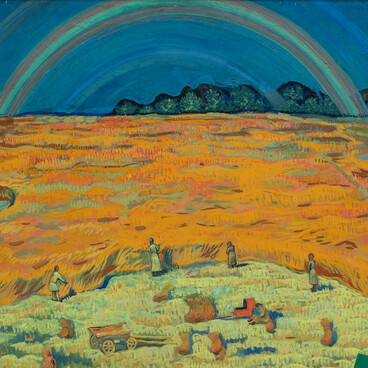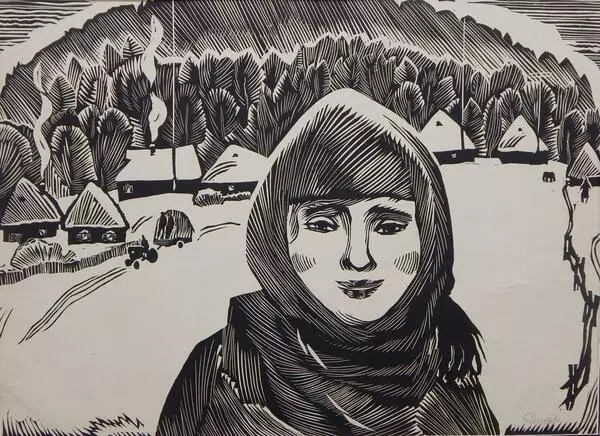Vitaly Petrovich Petrov (Praski Vitti) created numerous monumental and decorative paintings, ceramic mosaics, and stained-glass windows. He gained international fame for his work in the baking enamel technique. In recent years, his work has been dominated by paintings and graphic art, as well as book illustrations.
Born on September 17, 1936, in the village of Algazino, Chuvash Republic, into a large peasant family, he graduated from the Cheboksary Art College, then known as the department of monumental and decorative painting of the Leningrad Vera Mukhina Higher School of Art and Design. Since 1985, he has been living and working in Cheboksary.
The artist’s works include “Development of Transport”, “Peaceful Labor”, “The Book Bringing Light”, “The Native Land”, “Enlighteners of the Chuvash Land”, “Images Based on Chuvash Folk Embroidery and Konstantin Ivanov’s Poem Narspi”, “Family Portrait. Prague”, a series of portraits of poets, the cycle “Chuvash Motifs”, “My Contemporaries: Poet V. Turgay, Conductor M. Yaklashkin, Musician M. Mikhailov, Literary Critic A. Khuzangay, Art Critic A. Trofimov”, “The Face of a Chuvash Woman”, a series “Poetry of A. Blok” that consists of 176 drawings, and others.
Vitaly Petrov, who had been from his younger years fascinated by Konstantin Ivanov’s poem “Narspi”, once an artist, invented a creative method of translating his worldview through the images of the poetic work of the Chuvash classic. According to the artist, he was interested in trying to form a style that would combine the features of two source components. These are the subjective nature of ornamentation in folk art, which, in its symbolic interpretation of nature, people and the universe, borders on magical characters and scenic carvings, where a human being is de-personified, and modern methods of composition and depiction of scenes from everyday life of the Chuvash people.
Vitaly Petrov uses colors — red, blue, black, and others — in their original, innate meaning, trying to keep within the people’s natural perception of color values.
Most of his works are dedicated to the Chuvash. He uses scenes from the circle of life: youth, games, dates, separations, moments of anguish and expectation of happiness — life in its day-to-day activities, and at its sublime moments.
Born on September 17, 1936, in the village of Algazino, Chuvash Republic, into a large peasant family, he graduated from the Cheboksary Art College, then known as the department of monumental and decorative painting of the Leningrad Vera Mukhina Higher School of Art and Design. Since 1985, he has been living and working in Cheboksary.
The artist’s works include “Development of Transport”, “Peaceful Labor”, “The Book Bringing Light”, “The Native Land”, “Enlighteners of the Chuvash Land”, “Images Based on Chuvash Folk Embroidery and Konstantin Ivanov’s Poem Narspi”, “Family Portrait. Prague”, a series of portraits of poets, the cycle “Chuvash Motifs”, “My Contemporaries: Poet V. Turgay, Conductor M. Yaklashkin, Musician M. Mikhailov, Literary Critic A. Khuzangay, Art Critic A. Trofimov”, “The Face of a Chuvash Woman”, a series “Poetry of A. Blok” that consists of 176 drawings, and others.
Vitaly Petrov, who had been from his younger years fascinated by Konstantin Ivanov’s poem “Narspi”, once an artist, invented a creative method of translating his worldview through the images of the poetic work of the Chuvash classic. According to the artist, he was interested in trying to form a style that would combine the features of two source components. These are the subjective nature of ornamentation in folk art, which, in its symbolic interpretation of nature, people and the universe, borders on magical characters and scenic carvings, where a human being is de-personified, and modern methods of composition and depiction of scenes from everyday life of the Chuvash people.
Vitaly Petrov uses colors — red, blue, black, and others — in their original, innate meaning, trying to keep within the people’s natural perception of color values.
Most of his works are dedicated to the Chuvash. He uses scenes from the circle of life: youth, games, dates, separations, moments of anguish and expectation of happiness — life in its day-to-day activities, and at its sublime moments.




